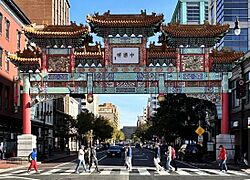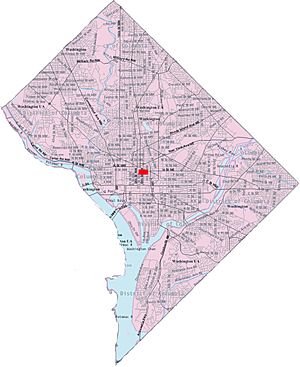Chinatown, Washington, D.C. facts for kids
Quick facts for kids
Chinatown
|
|
|---|---|
|
Neighborhood of Washington, D.C.
|
|

Chinatown's Friendship Archway, as seen looking east on H Street NW in November 2023
|
|

Chinatown within the District of Columbia
|
|
| Country | United States |
| District | Washington, D.C. |
| Ward | Ward 2 |
| ZIP Code |
20001
|
| Area code(s) | 202 |
Washington, D.C.'s Chinatown is a small, historic neighborhood in Downtown Washington, D.C.. It is mainly found along H and I Streets, between 5th and 8th Streets, in the Northwest part of the city. This area was once home to many Chinese immigrants. However, by 2017, fewer than 300 Chinese residents lived there.
This Chinatown is actually the second one in Washington, D.C. The first Chinatown was built around 1851 in the Federal Triangle area. It moved to the H Street area in 1931 when new government buildings were constructed. In 1986, a beautiful Chinese gate was built over H Street at 7th Street. Later, in 1997, large buildings like the Capital One Arena, a sports and entertainment center, were built in the area. The neighborhood is easy to reach by public transport, thanks to the Gallery Place station of the Washington Metro.
Contents
What is Chinatown?
A Historic Neighborhood
Chinatown is a special part of Washington, D.C., known for its Chinese culture. Many Chinese immigrants started moving here in the 1930s. They had to leave Washington's first Chinatown on Pennsylvania Avenue. This was because new government offices were being built there.
The new residents decorated their new neighborhood with Chinese signs and pretty metal designs. At its busiest, Chinatown stretched from G Street north to Massachusetts Avenue. It also went from 9th Street east to 5th Street.
Changes Over Time
Chinatown stayed a strong community until the 1960s. But after the 1968 Washington, D.C., riots in 1968, many Chinese residents moved away. They went to the suburbs in Maryland and Virginia. This was because the downtown area of D.C. became less safe.
In the early 1980s, the D.C. government built a new convention center. This caused more Chinese residents to move out of the area. To help, the city built the Wah Luck House apartments in 1982. These apartments were designed with modern Chinese styles to welcome the displaced residents.
The Friendship Archway
In 1986, the city built the Friendship Archway. This is a large, traditional Chinese gate. It was a project between Washington D.C. and its sister city, Beijing. The archway was meant to bring in visitors and honor the local Chinese community. Around the same time, the nearby Metro station was named Gallery Place-Chinatown.
In 1997, the MCI Center (now called Capital One Arena) was finished. After this big arena was built, some people felt that the neighborhood "barely" remained a true Chinatown. Today, many people see Chinatown as an example of an area changing a lot. By 2015, only about 300 Chinese-Americans lived there. Many of them were finding it hard to stay because of rising costs. Now, much of the Chinese cultural activity and shopping has moved to the suburbs outside of D.C.
Celebrations and Parades
Lunar New Year Parade
Every year, Chinatown celebrates the Lunar New Year with a big parade. This parade has been one of the city's main events for over 50 years. Lunar New Year is a celebration of light, honoring family and wishing for good luck. The parade is huge and features exciting dragon dances. In 2021, the parade was canceled due to the COVID-19 pandemic in the United States.
On February 10, 2019, the parade celebrated the year of the pig. It included traditional lion and dragon dances, firecrackers, and community groups. The parade route goes along 8th Street NW. In 2020, which was the year of the rat, the parade featured a person dressed as Caishen (a god of wealth) and another as a Giant panda.
Chinese Merchants Association Parade
Another parade in Chinatown is held by The Chinese Merchants Association. One famous parade happened on September 10, 1957. A photographer named William C. Beall was there to take pictures. A two-year-old boy named Allan Weaver asked a police officer, Maurice Cullinane, if he was a US Marine. This photo was printed in many newspapers and magazines, including the back cover of Life (magazine). It even won a famous award, the 1958 Pulitzer Prize for Photography. Beall named the picture Faith and Confidence.
Who Lives in Chinatown?
| Historical population | |||
|---|---|---|---|
| Census | Pop. | %± | |
| 1880 | 100 | — | |
| 1930 | 800 | — | |
| 2010 | 300 | — | |
| Chinese-American population | |||
In 2010, the area that includes Chinatown had about 3,000 residents. Only about 21% of them were Asian. This is a big change from 1990, when most of the people living there were Chinese American (66%).
Washington, D.C.'s Chinatown is smaller than other famous Chinatowns in the U.S. For example, it's smaller than the ones in San Francisco and Manhattan. About half of Chinatown's Chinese residents live in the Wah Luck House apartments. The closest Chinese supermarket is about 14 miles away in Falls Church, Virginia.
After the 1968 riots, many Chinese people moved out of Washington, D.C.'s Chinatown. They looked for safer places to live in the suburbs of Fairfax County, Virginia, and Montgomery County, Maryland. In 1970, there were about 3,000 Chinese residents in D.C.'s Chinatown. By 2016, this number was less than 600. Many of these were older people living in affordable housing. Today, areas like North Potomac, Maryland, and Rockville in Maryland, and Centreville in Virginia, have larger Chinese American communities.
Businesses and Places to Visit
With the building of the Capital One Arena, many old buildings were fixed up. They now house well-known shops and restaurants. This area has become a lively spot for nightlife, shopping, and entertainment. Even though many businesses are not Chinese-owned, they still have their names written in Chinese characters outside. This is because of city rules to keep the Chinatown feel. Many technology companies, like Blackboard, also have offices here. The Washington branch of the Goethe-Institut (a German cultural center) is also located in Chinatown.
Chinatown's most famous businesses are its about 20 Chinese and Asian restaurants. Most of these are owned by Asian American families. Some popular ones include Chinatown Express, Eat First, Full Kee, and Tony Cheng's. One restaurant, Wok & Roll, is in a building that was once the Mary E. Surratt Boarding House. Another restaurant is in a house that used to belong to the On Leong Chinese Merchants Association, one of the first Chinese groups in the neighborhood. This building is now a historic landmark.
The neighborhood also has a Chinese video store, several general stores, and Chinese American cultural and religious groups. There is one Chinese church, Chinese Community Church, located at 500 I Street. The Sixth & I Historic Synagogue has also been restored and hosts cultural events. The Washington DC Chinatown Community Cultural Center offers many activities and services.
Where People Live
As of 2019, the homes in Chinatown include rowhouses, apartment buildings (condominiums), and some townhouses. Many of these homes are rented. The Wah Luck House apartment complex, which opened in 1982, is home to many of the remaining Chinese residents.
Getting Around
The Washington Metro's Gallery Place station serves the neighborhood. This station opened in 1976 and is on the Red, Green, and Yellow Lines. Its name was changed to Gallery Place-Chinatown in 1986. Two important Metrobus routes also cross at 7th and H Streets. As of 2011, there is a monthly shuttle bus that takes residents of Wah Luck House to a suburban shopping center to buy ethnic groceries.
Chinatown's Look
The laws in Washington, D.C., require businesses in Chinatown to have their names in Chinese characters. This can be in either Traditional or Simplified Chinese writing.
The Friendship Archway, the community's large Chinese gate, was designed by Alfred H. Liu. He was the chairperson of the Chinatown Development Corporation. Building the archway started in June 1986. The idea came after Mayor Marion Barry visited China in 1984.
Learning in Chinatown
Students living in Chinatown attend District of Columbia Public Schools. As of 2019, the local schools are Walker-Jones Education Campus (a school for grades K-8) and Dunbar High School.
Chinatown in Pop Culture
In the film Game of Pawns, which was made for the FBI, D.C.'s Chinatown was used to look like Shanghai.



